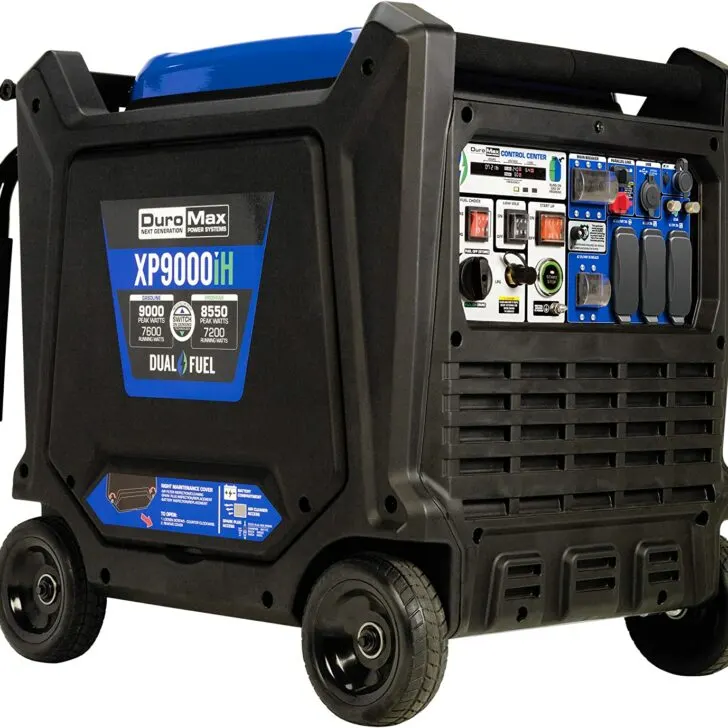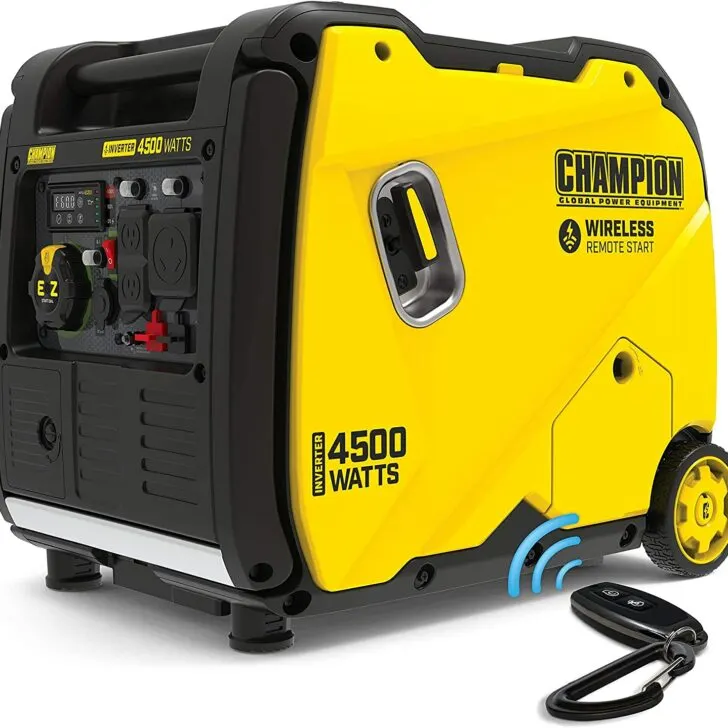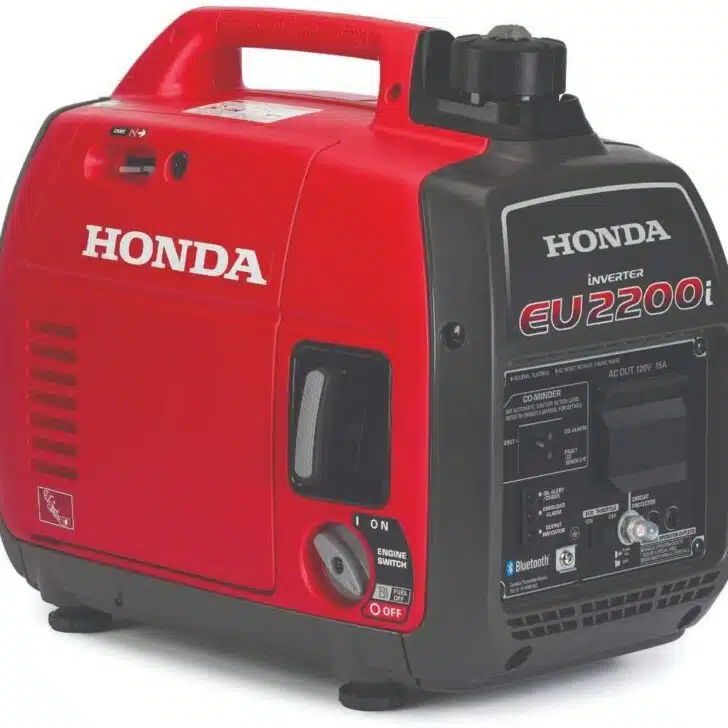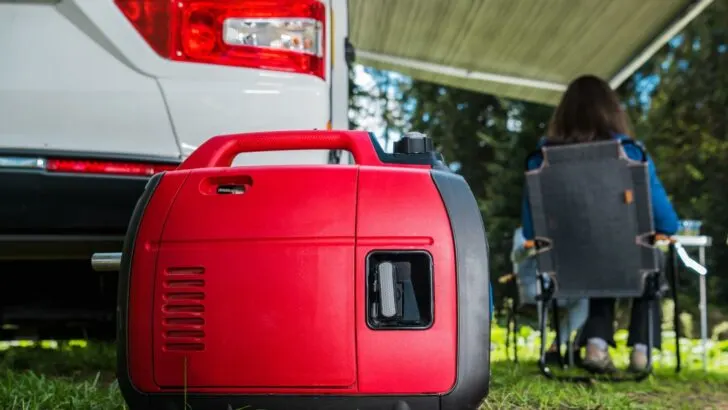Many of us are familiar with power generators. But what is an” inverter generator” and how is it different from a standard generator (if at all)?
In this post, we’re taking a look at inverter generators. We’ll talk about how they work and what their advantages and disadvantages are when compared with traditional generators. We’ll also consider who might benefit from having an inverter generator and why.
Let’s power through it!
- 1) What Is an Inverter Generator?
- 2) How Does an Inverter Generator Work So Efficiently?
- 3) How Big Are Inverter Generators?
- 4) What Are the Advantages of an Inverter Generator?
- 5) What Do I Need to Consider When Buying an Inverter Generator?
- 6) What Are the Best Inverter Generators?
- 7) Midsized Inverter Generators Popular With RVers
- 8) Is There a Silent Power Generator that Doesn’t Use Fuel?
What Is an Inverter Generator?
An inverter generator is a class of portable generators that really isn’t all that different from a standard generator in the sense that they’re both run by a fuel-powered engine that generates 120V AC power. (120V power is what you’ll find at a power outlet in your home.) But inverter generators produce that power differently.
A traditional generator uses an alternator to produce 120V AC electric power. An inverter generator uses an alternator to produce AC power as well but then converts it to DC (12V) power. An internal inverter then uses a microprocessor to change that DC power back into AC power. It may sound complicated, but the result is cleaner, more fuel-efficient power production.
The way an inverter generator works not only contributes to fuel efficiency but can also reduce the noise level of the generator significantly.
So, an inverter generator produces clean power with less noise and less fuel consumption.
How Does an Inverter Generator Work So Efficiently?
The main reason behind the efficiency of an inverter generator is its ability to throttle the engine up and down based on the demand being placed on it. A traditional generator, on the other hand, runs constantly at the same high level.
Since an inverter generator throttles the engine up and down as more or less power is required, rather than running at a constant speed regardless of the power demand, less fuel is used. This means that you don’t have to fill the fuel tank of an inverter generator as frequently as you would a traditional generator to power the same appliances and devices.
How Big Are Inverter Generators?
Inverter generators are generally categorized into three different groups that involve size and power output. Typically they’re classified as large, midsized, and recreational inverter generators.
Let’s take a quick look at their differences.
Large Inverter Generators

This Duromax 9000-watt inverter generator is an example of a large inverter generator. (Photo credit Duromax via Amazon.)
Large units typically weigh around 250 pounds or more. They come with wheels attached so they can be moved from place to place, but they’re really not intended to be portable.
They can generate 5,000 watts of power at 220 volts, so the power produced by a large inverter generator is sufficient to power a house during power outages.
In fact, a large inverter generator is capable of being connected to a home’s electrical panel using a transfer switch. This way the generator can power the circuits in the home directly, eliminating the need to plug appliances and electronics directly into the generator using extension cords.
Midsized Inverter Generators

This Champion 4500-watt unit is an example of a midsized inverter generator. (Photo courtesy of Champion via Amazon.)
A midsized generator generally weighs in the vicinity of 80+ pounds. Most include wheels for greater portability.
You may have seen midsized units carried by RVers to power such appliances as toasters, microwaves, and other items, including air conditioners.
Midsized units generate between 2,500 and 5,000 watts of power, but these can’t be connected to an electrical panel with a transfer switch. Instead, appliances and electronic devices are plugged directly into the generator.
Recreational Inverter Generators

This Honda EU2200i is an example of a small portable “recreational” inverter generator. (Photo credit: Honda via Amazon)
Recreational inverter generators generally weigh anywhere from 45 to 60 pounds and generate up to 2,500 watts of power. They’re designed to be hand-carried and are popular among van campers, RVers, and tailgaters.
Because these are so small, it’s important to remind anyone who may be new to using one that it’s critical to never use a generator of any size in an enclosed space due to the hazards of carbon monoxide.
All generators, no matter how small, must be used at a safe distance away from RVs or vehicles. Never use a generator inside a garage or other enclosed space.
What Are the Advantages of an Inverter Generator?
Inverter generators have several distinct advantages over traditional/standard generators.
- They tend to be smaller and more portable for the same power output.
- The speed of the engine varies based on the load or demand, saving fuel.
- Due to the fuel efficiency of inverter generators, they can run longer before requiring more fuel.
- They provide cleaner power that’s more consistent than construction generators or non-inverter models do, which is good for sensitive electronic devices.
- They’re considerably quieter than non-inverter generators, especially when lower power is being called for.
All of these advantages come at a premium, however. The disadvantage of inverter generators is that they’re more expensive than non-inverter generators.
What Do I Need to Consider When Buying an Inverter Generator?
There are a number of features you’ll want to look at when you’re shopping for an inverter generator.
Power Output
Before you start shopping, it’s a good idea to calculate your power needs. What appliances will you need to run and how much power do they require? Will you need to run more than one appliance at a time? Do you intend to run an RV air conditioner (or two)?
Remember that there’s a difference between surge/starting watts and running watts. For example, you may have a 13,500 BTU air conditioner that requires 2,750 watts to start up, but it only requires 1,250 watts to run.
There are a couple of ways to deal with the surge or start-up power requirements. You can buy a larger, midsized unit or you can buy a small, portable, recreational generator and use a soft start for RV ACs (as we do with our own HVAC system).
Once you’ve determined your power requirements, you can shop for an inverter generator that can supply that amount of power.
Fuel Type
Most inverter generators use either gasoline or propane. There are a few that run on diesel, and there are also dual-fuel inverter generators that are capable of running on gasoline OR propane.
Choosing your fuel type is important. After purchase, the most significant cost of running your inverter generator will be fuel. You’ll also need to have access to that fuel when you need it.
Fuel Tank Size
The size of your generator’s fuel tank and the load you put on it determines how long it will continue to run before refilling.
A larger fuel tank will allow your generator to run for a longer period of time. However, if portability is a priority, remember that more fuel in the tank also translates to more weight.
Weight/Portability
Speaking of weight, the weight of the generator on its own is a consideration when you’re shopping as well. Know how much you can carry and how portable you need your generator to be.
Noise Level

Some inverter generators are louder than others. Be sure to check the decibel ratings of the models you’re considering.
While inverter generators are quieter in general than non-inverter generators, their noise levels do vary.
When researching, be sure to check each model’s documentation for decibel levels and read user reviews.
Parallel Capability
Some RVers have the desire to use two of the smallest inverter generators (from the recreational class mentioned earlier) in parallel to run more appliances and electronics at once or to have sufficient power to run multiple air conditioners.
Some inverter generators have the capacity to be run in parallel, but not all do.
Warranty and Cost
As always, the cost of anything you buy, and its warranty, are important to consider when making a purchase.
What Are the Best Inverter Generators?
Following are several of the best and most popular models, particularly among RVers.
We’ll begin with what is arguably the most popular portable “recreational” inverter generator on the market — the Honda EU2200i.
Honda EU2200i
The Honda EU2200i has the distinction of being the quietest (only 48 to 57 dbA) and most powerful of the small, lightweight inverter generators available.
Long considered the gold standard of small, powerful inverter generators, it’s rated as generating 2,200 watts of power, though it’s regularly reported to exceed that without overloading. (2200 watts peak power/surge watts, 1800 running watts.)
Right at the start, we’ll tell you that this inverter generator is more expensive than many (if not most) small, lightweight inverter generators on the market, but users consistently review it as being well worth the price.
You get what you pay for, and with the EU2200i you’re getting an excellent Honda engine that’s larger than those in many other models. Users marvel at how it starts on the first pull every time they use it.
You can monitor the power output of the EU2200i from inside your RV using the Bluetooth app. It also has a built-in carbon monoxide detector so that if it detects high CO, it will automatically shut down.
The Honda EU2200i weighs just over 46 pounds and can run up to 8.1 hrs on less than a gallon of fuel, depending on demand. It will run for 3.2 hours at its rated load.
This inverter generator has the capacity for two to be run in parallel for 30 amps of rated power output.
Its only real negative is cost. But if you want the best, this is probably your go-to choice.
- MORE POWER. SAME LEGENDARY QUALITY. - The EU2200i delivers 10% more power than the previous EU2000i - enabling you to power more of what you need, in...
- CO-MINDER - Advanced Carbon Monoxide Detection System. CO-MINDER continuously monitors carbon monoxide (CO) levels. It automatically shuts down the...
YAMAHA EF2200iS
Right behind the Honda in terms of reputation and cost is the Yamaha EF2200iS. This, too, is a 2200-watt inverter generator with a powerful (79cc) 4-stroke engine and a great reputation. (2200 surge watts and 1800 rated/running watts)
The EF2200iS uses “Quiet Technology” which Yamaha attributes to a sophisticated muffler setup. That said, at 57 – 65 dBA it’s somewhat louder than the Honda EU2200i (48-57 dbA).
It’s also about 10 pounds heavier than the Honda, weighing in at just over 55 pounds.
The fuel tank capacity on the Yamaha EF2200iS is 1.24 gallons. Yamaha says it’ll run at 1/4 rated load for over 10 hours on a single tank of gas.
Like the Honda, the Yamaha offers parallel capacity for the ability to join two units for 30 amps of rated power. It has a 3-year limited warranty and a price to match that of the Honda EU2200i.
- Powerful Yamaha 79cc Engine - Provides high power output.
- Yamaha Quiet Technology - Outfitted with Yamaha sophisticated muffler for quiet operation.
WEN 56225i
A considerably less expensive option is the WEN 56225i, a 2,250-watt gas-powered portable inverter generator.
This one weighs in at 48.5 pounds and has a noise level of 53 dbA. It uses a 79.7cc 4-stroke OHV engine to produce 2250 surge watts and 1800 rated watts of power.
Its half-load run time is 6 hours on one gallon of gas, and it’s equipped with a low fuel shut-off, a low-oil shut-off, and built-in overload protection.
The control panel includes a couple of 5V USB ports as well as an ECO mode switch and a connection for a WEN parallel connection kit which would need to be used to join two of these generators together for greater output.
- Dimensions: 19" x 11.5" x 18.2" | Weight: 48.5 lbs.Dimensions: 19" x 11.5" x 18.2" | Weight: 48.5 lbs
- Extremely quiet 53 dB operation comparable to the sound of a normal conversation according to the US Department of Health and Human Services
Midsized Inverter Generators Popular With RVers
For the purposes of this post, we chose to highlight three of the smallest, lightest, and most portable inverter generators that are also highly rated. These are the type most RVers tend to carry.
However, in case you need more power than the small hand-carried recreational class of inverter generators provide, we’ll link to a couple of popular, highly-rated RV-ready midsized models to kick off your research.
Remember that these units are quite a bit heavier, at around 100 pounds, so they’re considerably less portable than the recreational units we highlighted above.
Champion 3400-Watt Dual Fuel
- Dual Fuel – Operate your 3400-watt portable generator right out of the box on either gasoline or propane, plus the unit holds 0.6-quarts of oil...
- Convenient Electric Start with 3-Position Ignition Switch – Battery included, plus Quick Touch Panel allows you to access all your controls in one...
Westinghouse iGen4500
- 4500 Peak Watts and 3700 Rated Watts at Less Than 3% THD; Telescoping Handle; Gas Powered; Remote Start With Included Key Fob, Electric and Recoil...
- Features a 5–20R 120V Duplex Household Outlet, an RV-Ready Tt-30R 30 Amp Outlet and Two USB Outlets – Great Choice for Travel Trailers or Home Use...
Is There a Silent Power Generator that Doesn’t Use Fuel?
There is! Solar power “generators” can be stored and used inside your RV and operate silently, but they’re very different from the fuel-powered inverter generators we’re highlighting in this post.
For details on the pros, cons, and limitations of solar generators, check out our post on solar generators for RVs.
Geek Out with Us Every Week
Join our newsletter to learn about all things RV-related. Every week we offer free tips, tricks, product reviews, and more to our online community of RVers. So, whether this is your first time on the road or you’re a seasoned expert, we’d love for you to geek out with us!







Charles
Monday 17th of July 2023
I have a 2500 watt Champion inverter/generator. I am breaking it in using propane. I get a slight smell of the chemical in propane coming from around the vents of the generator. i have checked all connections with no issues. I am reaching out to Champion, but do you know if it is normal to get a slight propane odor?
TheRVgeeks
Wednesday 19th of July 2023
Oh boy, Charles. We're not sure on that one. Definitely best to get Champion's input on whether or not that's normal... as, from an inexperienced point of view, we'd assume it was a hazard. Please let us know what you hear back from them, as that would be good for everyone to be aware of.
Dr. Mike
Saturday 8th of October 2022
Hello all Two items should be added to the article:
- Always use ethanol-free gasoline to prevent "gumming up" of the engine. - Like our big RV generators, even the portables should be "exercised" monthly.
Dennis Johnson
Tuesday 20th of September 2022
I don't know about what "regular generator" you're talking about, but my Champion runs at idle until you put a load on it, then it speeds up.
TheRVgeeks
Wednesday 21st of September 2022
Hi Dennis. Without knowing it, your Champion is likely already an inverter generator (they make several models of small, portable, gas-powered inverter-generators). Without the inverter, "regular" generators have to run at a steady, consistent speed to be sure the frequency of the AC power they're generating stays consistent. With an inverter-generator, the inverter circuitry handles that, so the engine can change speed to meet the power demand instead, allowing it to run slower (i.e. quieter and using less fuel) at lower demand.
Julie Schwartz
Monday 19th of September 2022
Since I am new to RVing and not much knowledge about inverters. Just curious our MH came equipped with an inverter switch on the control panel but I don’t know how or why I would use it. Dealer tried to explain but not sure it sank in. Can you provide resources about this built-in feature? Thank you
John S.
Sunday 18th of September 2022
Informative article and I learned something new today. Merci
TheRVgeeks
Tuesday 20th of September 2022
De rein, John!